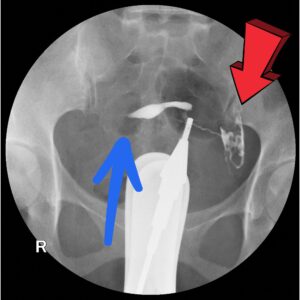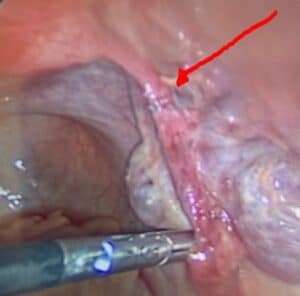Deciding you want another baby after having your tubes tied is a big decision. You only have three choices: in-vitro fertilization, adoption, or tubal reversal surgery.

Choosing tubal ligation reversal surgery will restore your body’s natural ability to become pregnant.
Tubal ligation reversal will allow you the chance to become pregnant each month and, if the surgery works, you can have more than one child.
Why would the surgery not work? One reason is your tubes could heal closed after the reversal procedure.
Most women will become pregnant quickly after reversal surgery. Unfortunately, some women will not become pregnant as quickly as they would like.
Many of these women will ask themselves how can you tell if your tubes are open after tubal reversal surgery?
Keep reading and we will answer this very common question.
Getting Pregnant After Tubal Reversal Surgery
Most women believe they will become pregnant immediately after reversal surgery. If they don’t say it…they all think it! Just like every woman believes they will have a twin pregnancy!
Some women are fortunate and will become pregnant soon after reversal surgery. For many women it will take longer than just a couple of menstrual cycles.
Dr. Monteith is the Medical Director of A Personal Choice Tubal Reversal Center in Raleigh North Carolina. Between 2000 and 2011, Dr Monteith maintained extensive statistics on over 9,000 reversal surgeries and patient’s chances of pregnancy.
His research revealed the best chances of pregnancy were in patients under the age of 35, those who had tubal clips and tubal rings as their tubal ligation method, and those with longer fallopian tubes after reversal surgery.
For more information: Tubal Reversal Pregnancy Study: 2000 to 2011
Although the time to become pregnant was not studied, Dr. Monteith observed most patients become pregnant within a year of actively trying. Dr. Monteith advises his patients to try to become pregnant as soon as they feel comfortable after surgery and to try for 12 months before getting worried.
If no pregnancy after 12 months then he advises them to consider having a test to tell if their tubes are open after tubal reversal surgery.
How Can You Tell If Your Tubes Are Open After Tubal Reversal Surgery?
There are the six (6) ways you can tell if your tubes are open after tubal reversal surgery:
- Hysterosalpingogram
- Hysterosalpingogram with selective cannulation
- Hysteroscopy with selective cannulation
- Diagnostic laparoscopy with chrompertubation
- Office hydrosonogram
- Getting pregnant
Getting pregnant is the best way to determine if your tubes are open. A HSG x-ray is the second best way to tell if your tubes are open after tubal reversal surgery.
Hysterosalpingogram Also Known As The HSG X-ray
A hysterosalpingogram (HSG) can help you tell if your tubes are open after tubal reversal surgery.
Although the term is a mouthful… hysterosalpingogram means: hystero (uterus), salpingo (tubes), gram (study)…. or translated…”uterine and tubes x-ray study”.
Hysterosalpingogram is a lot to say… and that is why many people refer to this test simply as the HSG test.
Dr. Monteith recommends you try to become pregnant for 12 months before having a HSG x-ray. Why? Because most patients will become pregnant within the first 12 months of trying and can avoid this unnecessary test.
Not only can the x-ray be unnecessary for many patients but there are also risks involved: pain, infection, cost, and false results.
Many women will have intense cramping and pain during the x-ray. The dye can introduce bacteria into the tubes. Health insurance will not always pay for the x-ray. Sometimes the test will say your tubes are blocked when they really may be open.

Red arrow shows open tube with dye exiting end of tube. Blue arrow shows tubal spasm.
To have a HSG, your local doctor must order the x-ray from a radiologist. You would then have the HSG performed in a radiologist’s office.
The x-ray is performed by putting a small catheter (or tube) into your vagina, through your cervix and into the uterine cavity. The radiologist will then push dye into your uterus and see if the dye travels down the tubes and out the end of the tubes. The radiologist will take x-ray pictures while they are performing the test. The flow of dye readily shows up on x-ray images.
If the dye travels down and out the end of the tube…then your tube is open. This is how the HSG is used to tell if your tubes are open after tubal reversal surgery.
The problem with the HSG is you can often get false results. How?
Sometimes the dye is injected into the uterus and the patient will have intense uterine cramps. The uterine cramping will cause temporary muscle spasms in the fallopian tubes. The tubal spasms will cause the tubes to temporarily spasm shut and will not let dye into the very opening of the fallopian tubes. In these cases the radiologist will advise you your tubes are closed…when in fact your tubes may actually be open.
If the HSG clearly shows your tubes are open…meaning dye clearly travels into the opening of the tube, down the tube, and out the end of the tube then your tubes are 100% open.
If the HSG shows dye does not even enter the tube…then the HSG test result may not be accurate.
Sperm are much better than radiology dye when it comes to traveling down and out the end of the fallopian tubes (even with tubal spasm).
Hysterosalpingogram With Selective Tubal Cannulation
Although these terms seem complicated they are easily understood with translation into simple English.
Hysterosalpingogram: hystero (uterus), salpingo (tubes), gram (study)…. or “uterine and tubes x-ray study”. Selective tubal cannulation means the doctor tries to insert a small cannulae (catheter/tube/guide wire) into the opening of each tube selectively… first one side and then they other side.

Selective cannulation of the tube attempts to physically overcome tubal spasm. Imagine closing your lips like you were going to start to whistle. This is what the tubal opening looks like when it spasms closed. Now imagine trying to force a straw through your lips in an attempt to overcome the muscles of the mouth. This is what selective cannulation does.
Some people mistakenly believe selective cannulation can be used to overcome true tubal blockage from scar tissue. Unfortunately cannulation can only overcome spasm, mucous plugging of the tubes, and tubal agglutination.
Most people can easily understand spasm of the fallopian tubes but they have never heard of mucous plugging or tubal agglutination.
Infertility experts are at odds as to how often mucous plugging and tubal agglutination can occur. To be honest, most doctors can’t clearly explain how mucous plugging occurs or if it even really exists or if it is temporary or permanent. These concepts seems like a good explanation to explain why a lot of women will experience pregnancy after some of these studies.
Tubal agglutination is very uncommon but it occurs when the walls of the fallopian tube gently stick together. Tubal agglutination is kind of like sucking liquid through a flimsy straw that collapses every time you suck on it. The straw walls collapse and fluid does not move through the straw.
Tubal agglutination could occur after an infection, after a full term pregnancy and breastfeeding, or after use of hormonal birth control with high levels of progesterone, ie depoprovera birth control injection. High progesterone levels decrease the thickness of the lining and this is why agglutination may be more likely to occur postpartum or with high progesterone hormonal medication. Infection…or trauma (like a D and C procedure)… may promote agglutination in these situations.
Hysteroscopy With Selective Tubal Cannulation
Hysteroscopy with selective fallopian tubal cannulation can also help determine if your tubes are open or closed.
Again…sounds complicated but really simple with translation: Hystero means “uterus” and oscopy means “to examine with a camera”. Selective cannulation means the doctor tries to push a guide wire through the opening of the fallopian tubes.
This procedure is usually performed by an infertility specialist. This is a surgical procedure that can sometimes be done in the office but is usually done in the operating room under IV sedation or general anesthesia. During this procedure, the infertility specialist inserts a small camera (hysteroscope) into the vagina, through the cervix, and into the uterine cavity. This allows them to see the inside of the uterus and the opening to the fallopian tubes.
Once they identify the tubal opening they attempt to insert a small guide wire (cannulation) into the very opening of each tube. The guide wires are too flimsy to travel down the entire length of the fallopian tubes…so the are usually inserted into the tubal openings for about 1 inch. The guide wires are also too flimsy to force open and serious blockage. The doctor will then attempt to flush dye into the opening of the tube.
These wires are way to flimsy to correct true tubal blockage from serious scar tissue. The only purpose of this study is to try to overcome tubal spasm to see if the tubes are really open or closed. It also may overcome tubal agglutination and flush out mucous plugging.
Laparoscopy With Chromopertubation Can Help Tell If Your Tubes Are Open
Another way you can tell if your tubes are open after reversal surgery is to ask your Ob/Gyn to perform a diagnostic laparoscopy with fallopian tube chromopertubation: diagnostic (study to check out) and laparoscopy (camera inserted into abdomen).

Chromopertubation showing dye not passing through tubal repair site. Red arrow shows blocked tubal repair site.
This is a surgical procedure that must be performed in an operating room under general anesthesia. While you are under anesthesia the doctor inserts a camera (laparoscope) through a small incision made in your belly button. At the same time they insert a small catheter (tube) through your vagina and cervix and into the uterine cavity.
The doctor then pushes dye into your uterus and tubes (chromopertubation). While they are pushing the dye into your uterus they are also looking at your tubes directly with the camera inserted into your abdomen to see if dye exits the fallopian tubes. If a tube is closed then dye will not spill from the end of the tube. If a tube is open then dye will easily exit the fallopian tubes.
Since a laparoscopy with chromopertubation is a surgical procedure performed under general anesthesia it is not recommended for everyone. It is not an easy test to perform.
Usually this test is reserved for women who may also have other surgical conditions (endometriosis, ovarian cysts, or adhesions/scar tissue) that need evaluation or correction. The thought being that the conditions that require surgical evaluation and correction can be fixed but also at the same time the doctor can check to see if the tubes are open or closed with the chromopertubation part of the procedure.
Office Hydrosonogram
The hydrosonogram test is sometimes used to determine if your tubes are open. Hydro means “water” and sonogram means “ultrasound”… so the hydrosonogram is a water ultrasound.
During this test, the doctor inserts a small catheter into the cervix and pushes water into the uterine cavity. At the same time they perform an ultrasound to visualize water as it flows into the pelvis.
The problem with the hydrosonogram is the ultrasound image quality is usually not good enough to see the water travel through the inside of the fallopian tubes. Yes you can see the water in the uterine cavity but you can’t easily see the water in the fallopian tubes. The doctor may see water collect behind the uterus but they may not be able to determine if the water is flowing through either the right, left, or both fallopian tubes.
A hydrosonogram may tell you if a tube is open but it may not be good enough to determine if only one or both tubes are open.
Best Way To Tell If Your Tubes Are Open After Tubal Reversal Surgery? Getting Pregnant!
The best way to tell if your tubes are open after tubal reversal surgery is to become pregnant! No joke.
During his post-operative consultation meeting with patients, Dr. Monteith frequently tells patients the best way to know if your tubes are open after reversal surgery is to become pregnant. Many couples will laugh because they think he is telling them something so obvious that it is funny….the reality is he is often being serious and honest.
Most people do not think of human reproduction this way but the reality is that sperm are drones.

Sperm are launched from the penis. They swim up the vagina, through the cervix, up the uterus and down the tubes. Once they find and egg and penetrate the egg they combine the fathers genetic material with the egg and the egg then starts to divide.
Once the egg starts to divide the egg releases human chorionic gonadotropin…or hCG…or the pregnancy hormone. A simple urine pregnancy test can detect pregnancy hormone.
Just because you get pregnant does not mean you are going to have a baby…you could miscarry…but a positive pregnancy test does mean a sperm was able to find and fertilize an egg. The egg can only be fertilized if a sperm was able to get to it…so that means your tubes (at least one of them)…is open.
This is why Dr. Monteith tells patients getting pregnant is the best way to tell if your tubes are open after tubal reversal surgery.
Dr. Monteith’s Recommendations: Relax And Just Have Sex
Although waiting a year for some women is extremely anxiety provoking, most women can save themselves the risks and costs associated with unnecessary testing to see if their tubes are open.

Relax and just have sex. Getting pregnant is the best way to know if your tubes are open.
Sperm are nature’s best at finding open fallopian tubes and fertilizing eggs. When a sperm fertilizes an egg you get a positive pregnancy test…and any positive pregnancy test is proof that at least one tube is open.
If you would like to optimize your chances of getting pregnant after tubal reversal then you should consider having your partner’s sperm checked and documenting ovulation.
You can easily document your ovulation with over the counter ovulation testing kit.
More information: Ovulation Testing: A Fertility Surgeon’s Advice
A semen analysis can easily be ordered by your local doctor to make sure the sperm count and motility are in the normal range.
Although a microscope test is the best way to check fertility there are over the counter home sperm fertility tests available that can be performed in the privacy of your home.









